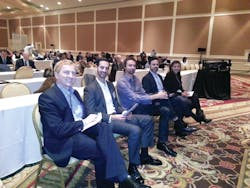Preparing for the Future
It’s the beginning of the year and the first conference of the year was the Transportation Research Board Annual Meeting. While talking with people between sessions, it was no surprise that the topic of the day was funding.
Discussions are underway about where we will be at post-MAP-21 while people are still trying to wrap their heads around MAP-21. While the FTA has been having webinars on MAP-21, there were 17 sessions at the TRB annual meeting that looked at different aspects of the legislation.
The Young Members Council at TRB was created to encourage and expand young professional participation in all aspects of TRB. The YMC had a variety of sessions and activities during the annual meeting, including a 6-minute pitch: Transportation Innovation and Entrepreneurs’ Challenge. If you’ve watched the television program “Shark Tank,” you know the format. Young transportation professionals have six minutes to present their cutting-edge concept and after the panel of judges questions and evaluates them, a winner is declared.
The audience heard about NAViSection, an ongoing driver evaluation program that enhancing reporting to inform driver licensing decisions; the petrochemical incident location system (PILS), which would be enhanced to include a mobile app so anyone, including the rural first responders, could identify transportation hazmat incidents and watch for trends; On-Time Arrival, an app that lets you know when you need to leave for the airport, based on your transportation preference, the current security wait and any flight delays; and a modern steam engine to bring higher-speed passenger rail to corridors, without the environmental impact. The session provided an interactive, fast-paced format that looked at some unique opportunities for the transportation industry.
During the Chairman’s Luncheon, U.S. DOT Secretary Ray LaHood thanked TRB for encouraging young people, talked about what has been done in the past four years and what lies ahead with MAP-21 and future funding challenges.
MAP-21’s only a two-year bill because that’s all the money Congress could find and over the next two years, LaHood said the big debate is not over what America needs, the debate is how do we pay for it. He said we all know what America needs but how do we have the resources we’ve always had in America to build the big infrastructure we’ve built in the past. “We need to make sure we don’t become a second-class country when it comes to infrastructure. We’ve always been No. 1 but we’re falling behind.
“They’re beating us because they’re willing to put the resources behind it.”Preparing for the Future
